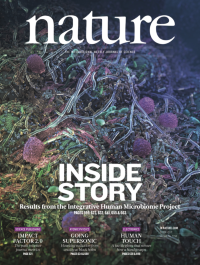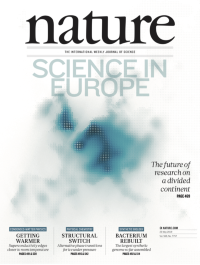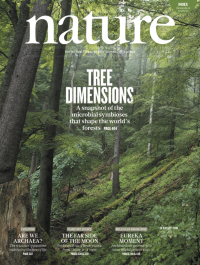Volume 569
-
No. 7758 30 May 2019
Inside storyThe Integrative Human Microbiome Project (iHMP or HMP2) concludes a ten-year initiative from the US National Institutes of Health aimed at exploring the interactions between humans and the diverse range of microorganisms living in their bodies. In this issue, teams from the iHMP Research Network Consortium present results and analyses from the project. In one paper, Curtis Huttenhower and his colleagues examine the dynamic changes in host–microbe interactions that occur in inflammatory bowel disease. In a second paper, Michael Snyder and his co-workers report on host–microbe dynamics in prediabetes, a condition that can lead to type 2 diabetes. A Perspective article provides an overview of the project and highlights how the results are providing insights into disease onset and progression that could pave the way for better diagnostics and treatments. The cover image is an artist’s concept of the diversity of human–microbe interactions.
Spotlight
-
No. 7757 23 May 2019
Science in EuropeThe European Union is facing a pivotal political moment. Populist, anti-EU sentiment is rising in some countries, and the bloc is preparing to lose one of its most powerful member states, the United Kingdom. Although positive economic forecasts suggest Europe as a whole is on the upturn, research spending in some countries hasn’t recovered since the global financial crisis. But researchers hope that these tensions won’t dent the region’s reputation for world-class, open and collaborative science — and are planning for what the next decade will bring. This special issue examines what the future may hold for scientific research in Europe, from the next Horizon funding programme to the issues the bloc must make a priority if it is to maintain its position on the global stage. The cover image represents the cities in Europe mapped by their publication output for 2018, according to the Dimensions database of scholarly literature.
-
No. 7756 16 May 2019
Tree dimensionsRoot-associated microbial symbionts have a strong influence over the way forest ecosystems function. The identity of the symbionts can help determine how easily trees access nutrients, sequester carbon or withstand the effects of climate change. In this week’s issue, Brian Steidinger and his colleagues present a global map of the symbiotic status of the world’s forests, drawn from a database of more than 1.1 million forest inventory plots and featuring some 28,000 species of tree. They find that there are sharp transitions between the dominant types of symbiosis, and that these transitions are largely driven by climatically controlled decomposition rates.
Nature Index
-
No. 7755 9 May 2019
A clash of wingsThe cover image shows an artist’s impression of the newly identified dinosaur Ambopteryx longibrachium. Described in this issue by Min Wang and his colleagues, the fossilized remains of Ambopteryx date to the Upper Jurassic period some 163 million years ago. Ambopteryx is a scansoriopterygid, a group of dinosaurs that are generally reconstructed as small, feathered arboreal climbers, with very long hands and fingers. But Ambopteryx is different — it is the second scansoriopterygid to be found with evidence for both feathers and bat-like membranous wings supported by an accessory bone called the styliform element. The first such specimen, Yi qi, was identified in 2015 and sparked a degree of controversy for its membranous wings. The discovery of Ambopteryx shows that Yi was not alone and raises the possibility that scansoriopterygids in general may have had bat-like wings in addition to feathers.
Nature Outline
-
No. 7754 2 May 2019
Feeling the heatAs global warming grips the planet, researchers hope to help guide conservation efforts by investigating which ecosystems and species are likely to be most severely affected by rising temperatures. In this week’s issue, Malin Pinsky and his colleagues assess 387 species of cold-blooded organisms for their sensitivity to climate change — and find that marine creatures are more vulnerable than terrestrial species. The researchers calculated the thermal safety margin — the difference between the maximum temperature that an organism can tolerate and the maximum temperature it experiences — for each of the 299 terrestrial and 88 marine species in the study. On land, the species most at risk were found in the mid-latitudes but in the oceans, they were at the tropics. The team suggests that the greater vulnerability of marine species is already taking its toll because local extinctions at the warm edges of species’ ranges are already twice as common in the ocean as they are on land.





